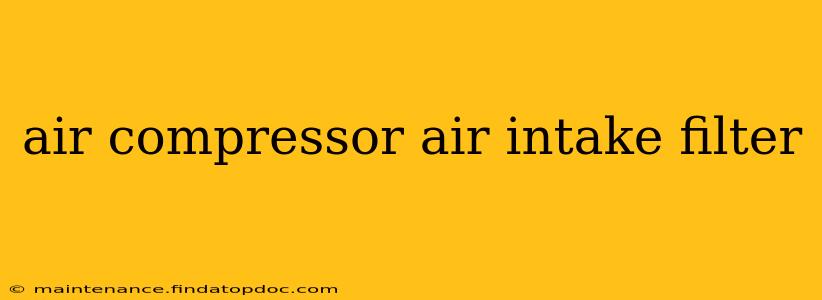An air compressor is a powerful tool, vital for countless applications from inflating tires to powering pneumatic tools. But its performance, longevity, and efficiency depend heavily on a seemingly small component: the air intake filter. This often-overlooked part plays a crucial role in protecting your compressor's internal mechanisms from damage and ensuring optimal operation. This comprehensive guide will explore everything you need to know about air compressor air intake filters, from their function and importance to maintenance and replacement.
What is an Air Compressor Air Intake Filter?
The air intake filter is a crucial component located at the air intake port of your air compressor. Its primary function is to filter out dust, dirt, debris, moisture, and other contaminants from the air before it enters the compressor pump. Think of it as the first line of defense, protecting the sensitive internal parts from potentially damaging particles. These contaminants can cause abrasion, corrosion, and ultimately, premature wear and tear, leading to costly repairs or even complete system failure. The filter typically consists of a porous material, often a pleated paper or synthetic fabric, designed to trap these particles while allowing clean air to pass through.
Why is the Air Intake Filter Important?
Ignoring the air intake filter can have serious consequences for your air compressor. Here's why maintaining a clean filter is critical:
-
Extended Compressor Lifespan: By preventing contaminants from entering the compressor pump, a clean filter significantly extends the lifespan of your machine. This translates to fewer repairs and replacement costs over time.
-
Improved Efficiency: A clogged filter restricts airflow, forcing the compressor to work harder to achieve the same pressure. This increased workload leads to higher energy consumption and increased wear on the motor and pump.
-
Enhanced Performance: Clean air ensures optimal compressor performance. Unrestricted airflow means consistent pressure delivery and improved efficiency in your pneumatic tools or applications.
-
Reduced Maintenance: Regular filter maintenance helps prevent more extensive and costly repairs down the line, saving you time and money.
How Often Should I Change My Air Compressor Air Intake Filter?
The frequency of filter replacement depends on several factors, including the environment where the compressor is used and the amount of use. However, a good rule of thumb is to inspect the filter regularly – at least once a month – and replace it every 3-6 months or as needed. If you notice significant dust or debris accumulation, replace it sooner. Operating in dusty environments will necessitate more frequent replacements.
How do I know if I need to replace my air intake filter?
This is a common question. There are several clear signs:
-
Restricted Airflow: Noticeably weaker air pressure or a longer time to reach the desired pressure is a sign of a clogged filter.
-
Visible Dirt and Debris: If you see a significant build-up of dust, dirt, or other particles on the filter, it's time for a change.
-
Increased Noise: A louder-than-usual compressor operation can indicate restricted airflow due to a dirty filter.
-
Compressor Overheating: A clogged filter forces the compressor to work harder, leading to overheating and potential damage.
What are the different types of air compressor air intake filters?
Air compressor intake filters come in various designs and materials, tailored to specific needs and environments:
-
Paper Filters: These are the most common and generally the most affordable. They effectively filter larger particles but may not be as effective against finer dust.
-
Synthetic Filters: These offer superior filtration compared to paper filters, capturing finer particles and extending their lifespan. They are generally more expensive than paper filters.
-
Oil-bath Filters: These use oil to trap dust and other contaminants. They offer excellent filtration but require regular oil changes and maintenance. This type of filter is less commonly found on smaller, portable compressors.
How do I clean or replace my air compressor air intake filter?
Cleaning a paper filter is typically not recommended. They are designed to be disposable. However, some synthetic filters can be cleaned; check your manufacturer's instructions. Replacing the filter is a relatively straightforward process:
-
Disconnect the power: Always disconnect the compressor from the power source before attempting any maintenance.
-
Locate the filter: The filter is usually easily accessible, often located near the air intake port.
-
Remove the old filter: Carefully remove the old filter, noting its orientation for proper reinstallation.
-
Inspect the filter housing: Check for any debris or damage within the filter housing and clean as needed.
-
Install the new filter: Carefully install the new filter, ensuring it's properly seated and oriented.
By understanding the importance of the air compressor air intake filter and following proper maintenance procedures, you can significantly extend the lifespan of your compressor, improve its performance, and ultimately save money on repairs and replacements. Remember, a small investment in regular maintenance can prevent substantial costs down the line.
